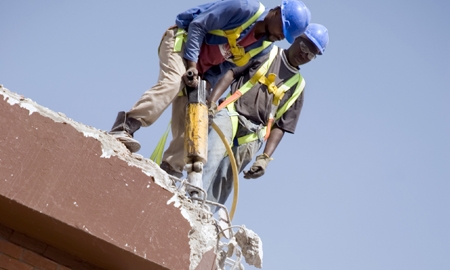An estimated seven million land mines were laid during the Angolan civil war, and though efforts to remove them are ongoing, their presence is hampering the progress of infrastructure development. It is a widespread belief that no sector was more affected by the war than transportation. Roads, railways, ports, airports and housing were left in such a state that the Angolan government estimates it will take from 10 to 15 years just to fix the damage suffered by the road network.
Rebuilding the country’s infrastructure is a foremost priority and vitally necessary for other sectors such as agriculture, to develop.
Jose dos Santos Ferreira da Silva, Angola’s Minister of Urban Planning and Construction, appointed in 2008, describes the scale of the problem: “The unplanned growth, together with the lack of water supply, energy, sanitation and housing in Luanda are the big issues that prevent the development of the capital city of Angola.”
Angola’s National Roads Institute (INEA) estimates that the government has injected $15 billion into building and rehabilitating roads across the country since 2006. Some $7 billion were invested in the northern region, $4 billion in the central region, $1 billion in the eastern region and $2.5 billion in the south of the country.
Over 70,000 kilometres of roads run through Angola and were usable in 1994, however in 2002 little paved network remained. Until recently, few roads were accessible, though INEA says that 74 per cent of Angolan roads are now paved and works continue.
According to Business Monitor International, the construction sector is expected to carry on growing; an annual average rise of 8.3 per cent year-on-year (y-o-y) is anticipated between 2011 and 2015.
Angola’s foreign trade depends almost entirely on the country’s deepwater ports (located in Luanda, Cabinda, Lobito and Namibe) as they manage 95 per cent of the nation’s imports, and the materials being used to reconstruct the country pass through these ports daily.
Due to serious congestion problems, particularly in the Port of Luanda, Sogester – the company responsible for operations in Angola’s main ports – is investing to dramatically improve efficiency of loading, unloading, customs clearance and cargo movement. The pressure is on as traffic is having to be diverted to Namibia’s port of Walvis Bay, 2,000km away.
The government is reported to have invested $200 million in repairing or replacing war-damaged tracks, principally on Angola’s major railway lines, the Caminho de Ferro de Benguela and Caminhos de Ferro de Luanda. Reconstruction for the latter began in 2005 and benefitted from a $350 million investment from the China Railway Construction Company, mainly in the form of labour and expertise.
Housing developments continue taking place all over the country as part of the government’s objective to build one million homes listed in the National Housing Program for 2012.
One such project is the Program for the Reconstruction of Southern Angola. It focuses on the “the suitability of land areas, respect for the environment, quality of infrastructure services planned for a social, economic and sustainable life,” says Mr Ferreira da Silva.
Another is the New City under construction in Kilamba Kiaxi, in Luanda. Mr Ferreira da Silva explains that 3,000 of the 120,000 apartments will be completed by mid-2012, and that the project includes sewer systems and telecommunications networks. The second phase will include the construction of a hospital, four clinics, police and fire stations.
Numerous challenges remain however. Though the oil and gas industries have driven the country’s economic growth, electricity and telecommunications reach only a small part of the population outside Luanda. The government has said it will invest more than $500 million into the power sector in the following decades.
Another of the Minister’s aims is to safeguard the transparency of public managers as he considers Angola has now entered a new era of state administration. He says, “the power and performance required of those serving in public administration is now added with a higher level of demand and a behaviour consistent with a moral attitude.”

0 COMMENTS